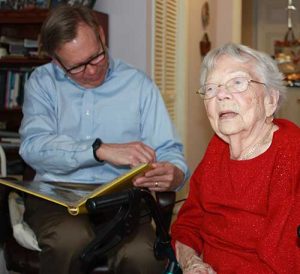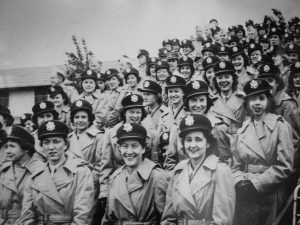
We had the opportunity to visit with Kathleen, her son Travis and her daughter-in-law, Katie, on the afternoon Feb. 13, 2015. Kathleen shared her story with us, gave us a living glimpse into history, and trusted us with the privilege of telling her story — all in an afternoon visit over tea, cookies and conversation.
Later that evening, Kathleen passed away in her sleep. She was 95 years old.
“I think she felt after she gave you her story that her work was done,” Katie said. “She had told her story before, but I could tell she had a special connection with [Dawne] and [you], a sort of entrusting you with the past. She could sense you valued it and would keep the lessons and struggles alive to tell future generations. Thank you for being willing to accept her sacred trust. Thank you for realizing the value of talking to the last living member of the 65th. Today that chapter of history closes.”
It was humbling to talk to Kathleen and be in her presence. Listening to her experiences as nurse in WWII made history and the purpose of our exhibit all the more real.

Smith was one of six children. She graduated from Lowe’s Grove School and, to her father’s dismay, attended Watts School of Nursing right out of high school. Smith recalls her father saying the work would be too hard.
After graduating from Watts in 1942, she worked on Strudwick Ward, a women’s ward at Duke Hospital, for six months. At that time, Duke was organizing the 65th General Hospital, which was reactivated from WWI, known then as the 65th Base Hospital.
Smith joined the 65th as part of the U.S. Army Nurses Corps and spent about a year training at Fort Bragg, NC, where she also met her future husband, Elbert Francis Smith (Frank), a paratrooper, from Ft. Benning with the 82nd Airborne Division. The initial plan was for the unit to go to Africa, but as the war escalated, their assignment was changed to England. First they went to Malvern and then were assigned to the 8th Air Force in Redgrave-cum-Botesdale, England. The hospital was the only one of its size in England at the time and the only hospital capable of handling mass casualties.
Stacks of photo albums and bound booklets that contain collections of pictures, letters and news clippings sit in between Kathleen, Dawne and me. She flips through a bound booklet throughout our conversation, using it as an outline of sorts and reading letters or news stories aloud from it occasionally. Her diploma from Watts School of Nursing hangs on the wall behind us.
Smith said that she and her fellow nurses took care of the “guys from the Air Force” after they returned from daily bombing runs to Germany. There was a strong camaraderie among the nurses who lived together in barracks, sharing their experiences and whatever supplies were sent from home. “We were close, six to a barrack,” she said. “I learned how to eat sardines.”
About 1,000 B-17 planes flew out in formation over the hospital every morning. The planes would leave in a beautiful formation, “you couldn’t miss it, even if you were asleep,” Smith described. But as tidily as the planes left, sometimes only half of them struggled to return to the base one by one. Sometimes the nurses would receive warning about the condition of the returning airmen, who’d land in planes and arrive to the hospital by ambulance, and would use this time to prepare for what they called ‘flak time.’ Smith tells us how she recalls the men who flew these missions regularly, how they kept their spirits up and bravely kept flying the missions day in and day out.
The conditions were very primitive, but Smith recalls the English people being very appreciative that the 65th was there. “There was no way to know how the whole of us felt. We were together, working to beat Germany…The whole United States was ready to do anything to stop the Germans; they all felt if we didn’t end the war at that time Germany might be over here, too.”
“We were so close [as a country] then compared to how separated we are now,” Smith shared. “It’s a big disappointment for me now — how much we’ve given and how many lives were lost.”
Smith said they weren’t very busy until D-Day, and then they were very involved, working long hours and taking care of patients coming back from their bombing missions. “D-Day was a bad day,” she recounts. “We were all anxious knowing that it had to come, but not knowing when.”
She reads aloud a letter from George Stebbings, who at the time was a 14-year-old English boy that lived close to the 65th. He thought all of the nurses were beautiful and brought them strawberries, although his family didn’t have anything, either, Smith said.
She and Stebbings kept up with one another until he passed away a few years ago, and then she continued to correspond with his widow. He wrote to her to let her know that there was a room dedicated to the 65th General Hospital with a large display of surgical instruments inside the Rougham Control Tower Museum in Bury St. Edmunds.
Smith recalled several of the doctors she worked with or knew about, many of whom are known for the medical innovations they made during the war. Dr. Ivan Brown, a neurosurgeon, was the most famous doctor they knew of, who she described as down-to-earth and friendly. He established one of the first blood banks in Europe, and started another one at Duke after the war.
“Dr. Brown was so special. He looked after us like he was our father. He was so interesting, so smart, so everything.”
She also recalled Dr. Clarence Gardner, who developed a method of heart surgery that had never been done before in battle. Gardner was faced with a soldier who had metal flak in his heart, which he was able to remove with his finger and string. “The soldier had no other course,” Smith said. “But, they all lived and had families.” Gardner performed heart surgery to three other patients during the war.
Travis, smiling, urges his mother to tell the story of how she “got her wings,” for us. Kathleen obliges and explains that just like the parachutists who earned their “jump wings” during training, to qualify as a paratrooper’s girlfriend, she had to jump off the living room table in the nurses barracks at Ft. Bragg. The vision of this memory, which has likely been told countless times, makes us all laugh.
Kathleen and Frank left Ft. Bragg at the same time. The 82nd Airborne Division was first deployed to North Africa, participating in the 82nd’s first major airborne combat operation jumping into Sicily. After multiple operations, Frank went back to England for the rebuilding of the 82nd’s 504th Parachute Infantry Regiment, where he reconnected with Kathleen, just before D-Day.
Kathleen and Frank married on July 22, 1944. Because Capt. Smith was assigned to Eisenhower’s allied staff, the couple had to get permission from the future president to get married. Six months later, Kathleen returned to Durham, expecting their first child, a daughter, Diane.
After the war, her husband stayed in the military and their family moved around in North and South Carolina. Frank helped to strengthen the ROTC programs at Duke, NCSU and UNC, and went on to serve in the Korean War, helping to establish the Korean War College and lead tactical air support for the Republic of Korea Army. Their son Travis was born at Ft. Jackson after the Korean War.
It was about 15 years after the war before Kathleen went back into nursing. She worked with Dr. Joseph Greenfield in cardiology at the Durham VA Hospital until the early 1970’s.
We flip through a photo album from 1995 when Smith went back to England for the 50th anniversary of D-Day. She visited Cambridge [American] Cemetery and chapel and said she was able to put together what happened to people from the 8th Air Force (The “Mighty Eighth”).
“Going back was really — I appreciated it,” Smith said.
After many years of meeting annually, the last reunion of the 65th General Hospital occurred in 2002, when the group dedicated a sculpture in honor of the Hospital’s efforts in WWII. The sculpture is on Duke’s medical campus and depicts a wounded soldier being aided by a nurse, a physician, and a corpsman. The artist, Stephen H. Smith, used Kathleen’s brown and white striped uniform as a model, Smith’s family told us.
As we finished our tea and parted ways, Kathleen apologized, saying it’s still hard for her to talk about her experience in the war, but that she hoped we got “all the facts” we needed. I thanked her, but it hit me that trying to convey my gratitude and understanding was too much to fit into a handshake goodbye. I wanted to hug her, thank her for her sacrifice, and tell her how much I admired her as a woman for doing something that I couldn’t have done myself. I didn’t say any of that as we locked eyes. Instead, I hope I conveyed my trust.
Donations may be made in the Memory of Kathleen G. Smith to Watts School of Nursing, 2828 Croasdaile Drive, Ste. 200, Durham, NC 27705 to further nursing education.
By Anne Dudley, Communications Manager, Health Sciences Library